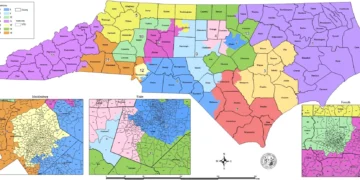June 17, 2025 Story by: Publisher
A federal trial opened on Monday, June 16, before a three-judge panel, where witnesses testified that the Republican-drawn 2023 redistricting maps fractured Black communities across North Carolina, weakening their political voice and violating the Voting Rights Act.
Plaintiff Testimony
Plaintiffs, including the North Carolina State Conference of the NAACP, Common Cause, and several individual voters, contend the districts amount to unconstitutional racial gerrymanders, violating the Equal Protection Clause and Section 2 of the Voting Rights Act.
Former state Rep. Earl Jones, a plaintiff in one of two consolidated suits, testified that Greensboro’s new congressional boundaries were “like a glass smashed against the pavement,” describing a district so fragmented that pockets of Black voters were dispersed into surrounding white-majority areas.
Jones testified on the first day of the federal trial of North Carolina’s congressional and state legislative districts. He is a plaintiff in one of the two lawsuits claiming the election districts Republicans enacted for the 2024 elections are racial gerrymanders that dilute Black voting power in violation of the U.S. Constitution and federal law.
Overall, seven Democrats and seven Republicans were elected to Congress from North Carolina in 2022 using the court-ordered map. The 2024 map yielded 10 Republican and four Democratic winners.
Jones, a Democrat, said he was drawn into the 5th Congressional District, which extends west to include Ashe and Watauga counties in the mountains. Republican U.S. Rep. Virginia Foxx represents the district.
While Manning supported the Black community, Foxx has been absent and doesn’t have an office in Greensboro, Jones said.
“It hurt my community,” Jones said of the district lines. “We don’t have anyone who will address issues important to us.”
This testimony echoed throughout the first day of hearings in Winston-Salem, where plaintiffs—including the North Carolina NAACP, Common Cause, and nearly 20 Black and Latino voters—argue that the new maps “dilute Black voting power in violation of the U.S. Constitution and federal law”.
Targeted districts under scrutiny
Witnesses detailed manipulation across multiple regions:
- Piedmont Triad (Greensboro, High Point, Winston-Salem): Critics claim the maps split urban Black voters across several congressional districts, rendering their influence ineffective.
- Charlotte–Mecklenburg and surrounding counties: Testimony revealed that Inner-City Wilmington was shifted into rural Brunswick County under Geo. Senate District 8—another move plaintiffs assert was designed to limit Black electoral clout.
All together, six of 14 congressional districts, nine of 120 state House districts, and five of 50 state Senate districts are being challenged.
The judges heard testimony about congressional districts 12 and 14 in Mecklenburg and counties west, about state Senate districts 1 and 2, which divide eastern North Carolina’s Black Belt counties, and about state Senate District 8, which is dominated by Columbus and Brunswick counties, with a few Black neighborhoods in Wilmington added for 2024.
GOP’s defense: partisan, not racial
Republican legislators maintain that the maps were drawn based on political metrics, not race. Their counsel told the court that race-based data were not used and that allegations of partisan gerrymandering are being improperly reframed as racial concerns.
Citing legal precedent, they argued the legislature relied on permissible partisan criteria consistent with recent Supreme Court guidance that limits federal scrutiny of partisan mapping.
Legal context
Court filings submitted ahead of the trial assert that state Senate leaders intentionally rushed the redistricting process in October 2023, preventing meaningful public input—especially from Black communities—and sidestepped required analyses under Village of Arlington Heights v Metropolitan Housing Dev Corp. and the Thornburg v Gingles factors.
What’s next?
The trial runs through early July. Following witness testimony, both sides will submit final briefs by August. A ruling could compel new district maps in time for the 2026 elections—or allow current maps to remain through 2030.
Why it matters
North Carolina’s maps directly influence political representation: the 2024 elections flipped three Congressional seats from 7–7 to a GOP 10–4 majority—a shift plaintiffs attribute in part to the redistricting changes.
This case reignites longstanding debates over racial vs. partisan gerrymandering and follows decades of legal battles that began as early as Shaw v. Reno in the 1990s, raising pressing questions about representation, accountability, and democratic legitimacy in the face of racial inequality.
Source: AP News / Carolina Journal / NC Newsline

















